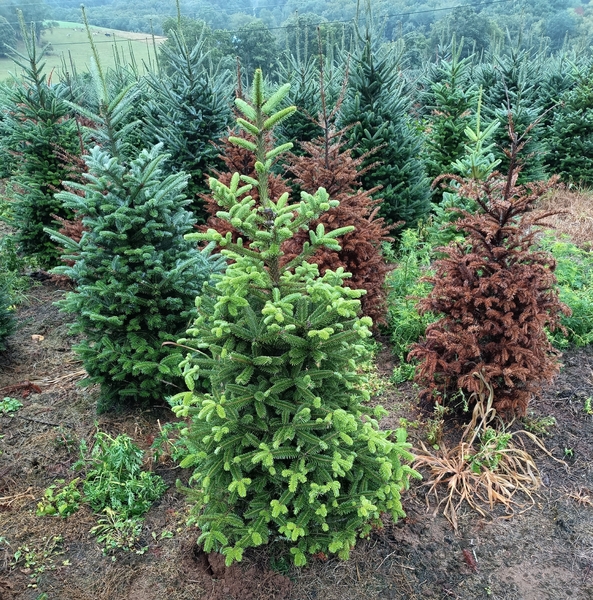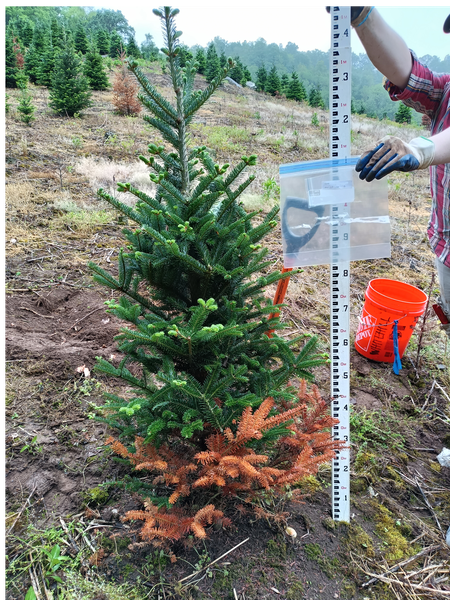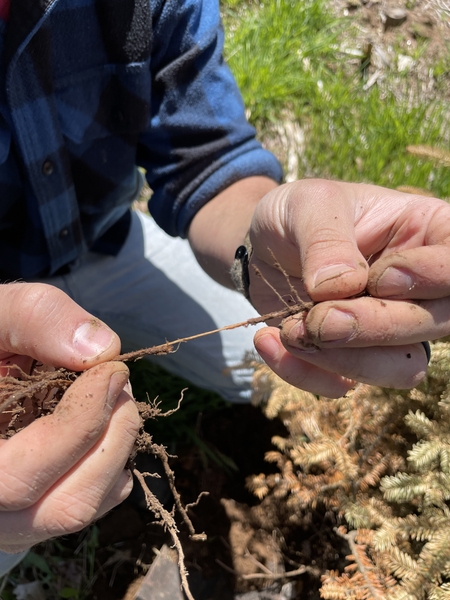
NC State Extension Resources

NC State Extension Resources
Phytophthora root rot (PRR), caused by several Phytophthora species, has been associated with significant damage to Fraser fir since the 1960s. Phytophthora is a fungus-like oomycete that inhabits the soil and infects many woody plants through the roots. With the production of chlamydospores as long-term survival structures, Phytophthora can lie dormant in the soil for several years, waiting for a susceptible host such as Fraser fir and the right environmental conditions, including warm soil temperatures (above 54°F) and saturated soils to infect plant roots. Due to this persistence, once Phytophthora becomes established on a site, the area is typically no longer able to be used for non-grafted Fraser fir production, making this disease one of the major limiting factors for Christmas tree growers.
The above-ground symptoms of Phytophthora root rot on Fraser fir include yellow-green needles, wilting, slow growth, delayed bud break, dead branches, and tree death (Figure 1). The needles remain on dead branches and turn cinnamon brown. Roots of affected trees are also cinnamon-colored to black and lack white growing tips. The outer surface of the root can be pulled away from the inner core, also called 'root sloughing,' and fine, feeder roots are often absent. Cutting into the bark of the trunk of the tree below symptomatic branches may reveal butterscotch colored wood (Figure 2). Often these symptoms are initially present on only one side of the tree or on lower branches since Phytophthora first infects a root and grows toward the trunk on that side, often described as PRR ‘flagging’ (Figure 3). Eventually the entire tree will die. Infected trees are usually found grouped together in a field or bed following above-ground water drainage. Unfortunately, a tree may be infected with Phytophthora months before the above-ground symptoms begin to develop.
Tree symptoms can have other causes than disease such as white grubs, transplant shock, fertilizer burn, and other problems. To determine if yellowing or dying seedlings or trees have Phytophthora root rot, contact your local N.C. Cooperative Extension agent to collect root samples. These root samples should be sent to the Plant Disease and Insect Clinic (PDIC) at NC State in Raleigh to determine if the pathogen is present.

Figure 1: Typical PRR “hotspot” with the frontmost tree showing the beginnings of PRR symptoms with PRR-killed Fraser fir in the behind it. The bright lime-green foliage is often the first symptom seen in Fraser fir to PRR, though may also be due to nutrient deficiency. Identification of other PRR symptoms present can help to confirm PRR diagnosis.
Caleb Cothron

Figure 2: PRR bark canker on Fraser fir. The visible butterscotch coloring of underlying tissue in and around the trunk canker is distinctive of P. cinnamomi.
Caleb Cothron

Figure 3: Fraser fir beginning to show PRR symptoms. Most apparent is the “flagging” of the lower branch on one side of the tree. If you were to peel back the bark at the trunk at the orange branch you would see something like in Figure 2. Another PRR symptom present here is the delayed budbreak of this tree relative to other trees in the plot.
Caleb Cothron
Phytophthora root rot is caused by several species of Phytophthora. In western North Carolina, the most prevalent and devastating species is P. cinnamomi. Often called a water mold, P. cinnamomi produces spores in response to near-saturated soils and favorable conditions. Phytophthora may remain dormant in the soil for many years as mycelium (hyphae threads) in infected root pieces or as chlamydospores, a thick-walled resting spore. During the growing season when soils are warm and wet, mycelium or chlamydospores produce sporangia. These lemon-shaped structures cause new infestation either by germinating and colonizing roots, or by releasing zoospores that have formed inside each sporangium. Though primarily spread through water movement, zoospores can swim short distances by means of flagella and are capable of directing their movement towards the roots of host plants based on chemical attraction.
The pathogen can be introduced into a field by contaminated equipment, with infected nursery stock, or with water runoff from nearby infested sites. Of these, transplanting infected seedlings represents a major contribution to disease incidence. Growers bringing in transplants from other states may also introduce new Phytophthora species to western North Carolina as recent studies have identified.
Controlling Phytophthora root rot requires an Integrated Pest Management approach. No single control strategy will prevent or control this disease. As with most plant diseases, the best control is through healthy seedlings and transplants, and proper site selection. If trees become infected with Phytophthora, management should change to practices that reduce the spread of the disease and minimize financial loss. Each step outlined in this note will help reduce the risk of getting and spreading this disease.
Phytophthora spreads quickly in seed beds or transplant beds because the seedling roots grow closely together, allowing the Phytophthora to grow from one tree to another. Phytophthora can be carried to the field on or in infected transplants. Unfortunately, a transplant can appear healthy for several months after it has been infected.
To ensure the cleanest transplants possible, follow these steps:
If Phytophthora is diagnosed and diseased seedlings are isolated to one corner or section of a transplant bed, you may still be able to use plants in the rest of the bed or adjacent beds. Contact your local N.C. Cooperative Extension agent to help you determine if it is safe to use plants from unaffected parts of a bed. Remember that an apparently green and healthy plant may be infected.
Soils may only need to be saturated for several hours for Phytophthora to infect roots. Fraser fir should only be planted in fields where water drains quickly down through the soil as well as drains quickly off the field. Examine a potential field site for any areas where water collects or drains. Are there wet weather springs? Does a culvert drain onto the field? Be sure when placing field roads that problems with water drainage aren't created. It may be necessary to go to a site during a heavy rain to observe water drainage.
Examine the soil at potential field sites to determine how easily water will drain down through the soil profile. A high clay content decreases water flow and holds water longer. Not only is clay in the topsoil a potential problem but also clay in the subsoil. Hardpans and shallow soils will slow water flow. Compacted soils also hold more water and slow water flow down through the soil. In the largest field study of Fraser fir of over 250 sites conducted by NC State University, clay content of the subsoil and shallow soil depth were the two most important site factors to determining Phytophthora incidence.
If fields are to be cleared of brush with heavy equipment, special care should be taken to reduce soil compaction and the loss of topsoil since this will increase the risk of Phytophthora root rot. Do not use heavy equipment when the soil is wet. Do not push topsoil off the site. Sow a cover crop in the field to help repair soil structure after clearing before trees are set.
Phytophthora can infect several hundred species of plants including red bud, dogwood, rhododendrons, mountain laurel, white pines, and honeysuckle. There is a slight possibility that woodlands cleared for Fraser fir already have Phytophthora in the soil. Also, growers setting Fraser fir in old apple orchards or where apple trees were growing in old pastures have had problems with Phytophthora. Several species of Phytophthora are associated with apple roots and appear to infect Frasers planted nearby. Grass and clover are not hosts and Phytophthora are not likely be present in old pastures.
Phytophthora is attracted to roots of a susceptible hosts. A healthy, robust root system may help delay the inevitable death of the Fraser following Phytophthora exposure. The following measures will improve root health:
Even with care, Phytophthora root rot can develop, especially after heavy rainfall or flooded conditions. The following steps may reduce disease spread and tree loss:
Quarantine areas of the field where trees are dying with Phytophthora. Soil from these infested areas can carry the Phytophthora spores. When working in trees, visit infected areas last. Don't carry mud on boots or equipment to areas of the field where trees are not dying. Wash soil off of boots or equipment with water and chlorine bleach when moving from contaminated to clean farms or use disposable plastic boot coverings when in Phytophthora contaminated sites. Keep a ground cover on quarantined areas to reduce the spread of soil infested with Phytophthora to clean locations.
The best way to manage Phytophthora root rot is to never get it. Disease-free seedlings and transplants, and site selection and sanitation continue to be the mainstays of Phytophthora root rot management.

Figure 4: Root “sloughing” typical of Phytophthora root rot disease on Fraser fir. The outer portion of the root easily slides off as it has been completely rotted by Phytophthora attack.
Will Kohlway
N.C. Cooperative Extension prohibits discrimination and harassment regardless of age, color, disability, family and marital status, gender identity, national origin, political beliefs, race, religion, sex (including pregnancy), sexual orientation and veteran status.
Recommendations for the use of agricultural chemicals are included in this publication as a convenience to the reader. The use of brand names and any mention or listing of commercial products or services in this publication does not imply endorsement by NC State University or N.C. A&T State University nor discrimination against similar products or services not mentioned. Individuals who use agricultural chemicals are responsible for ensuring that the intended use complies with current regulations and conforms to the product label. Be sure to obtain current information about usage regulations and examine a current product label before applying any chemical. For assistance, contact your local N.C. Cooperative Extension county center.